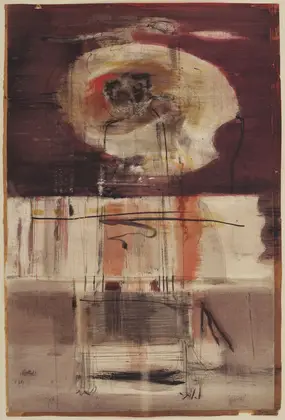This abstract piece perhaps resembles a human or alien figure, with a large circle at the top of the composition which could be a form of head. The central area then widens, as if someone has their arms open wide ready for an embrace and the element further down could be an alternative version of a figure's legs. That said, this might even be some sort of bird figure, in a similar manner to how Miro worked for a number of years within both painting and also sculpture. The potential head is created from where paint is not applied in the top region, with brown paint leaving a circular window in the centre. The forms are rough and approximate as Rothko works from feeling and emotion rather than attempting to produce a realistic depiction. We also find a variation in medium, with some thin lines similar to sketching, and then big slabs of paint elsewhere. There is almost a graffiti style to this approach and although this painting is not particularly well known, it is important to see this alternative style from within Rothko's career during the 1940s.
Rothko made use of watercolour and ink on paper to produce this piece. It is around one metre in height, and two thirds of that in width. He would use much larger canvases later on in his career and perhaps saw this piece more as an experiment in different artistic styles and techniques. Other items from around this time even made use of egg tempera, an idea inspired by his knowledge of traditional art from the Italian Renaissance. He would therefore try out all manner of different mediums as he progressed and evolved, always seeking new ideas and ways of expressing himself. As contemporary art turned its back on what had gone before, there were no restrictions left on how one would now proceed into the future.
MoMA have acquired this piece and own a number of other artworks from Rothko's career. They continue to be one of the most important art galleries in the world, and particularly significant within the sphere of contemporary art. You will find most other major American artists featured here from across the 20th century and they continue to add new items to their large permanent display each and every year. There has been a growing interest in contemporary art of late, with younger audiences particularly enthused, and so it appears that galleries such as this are the most likely to see a rise in visitor numbers in the years that follow. Those interested in Rothko's career will find many related artists featured here on opposing walls, allowing them to build up a better understanding of the overall contemporary art scene within the US across the 20th century, with also some other notable international artists also featured elsewhere within the collection.

